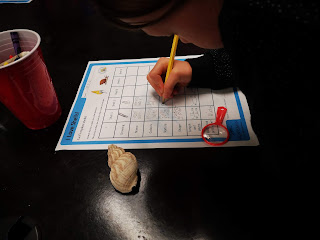One Day 1 we explored molluscs (animals that usually have shells) from the Bay of Fundy.
Look at the moon snail slime!
How many eyes does a scallop have?
Making observations of different types of shells.
Exploring the intertidal zone.
The group found lots of green crabs!
The participants learned how to handle the live creatures safely.
We even found a crab moult. This is the leftover exoskeleton which means there is a bigger crab out there.
We even found a few fish in the tide pools!
How many pennies can your boat hold? The record was 72!
Making a tidal craft.
Day 2 started with an experiment to see which plastics float and which sink.
We also discussed what animals in the ocean might encounter the different plastics and how this can harm the animals.
Using marine debris collected from local beaches to create art.
Sea turtle from marine debris.
Using rope found at the beach to create bracelets.
Thank you to our rope bracelet model!
We challenged the students to design and create marine debris collectors. There were lots of great ideas!
We collected some marine debris while at the beach.
Day 3 was Sea Star Day and we had a few more participants join our group. Pictures for Sea Star Day can be found here.
Day 4, as with all days, began at the touch tanks before the aquarium opens. She picked up a lobster all by herself and discovered the lobster is carrying eggs!
Fun at the beach.
Green crabs are a common find under the rocks and seaweed.
A less common find was a sea urchin.
The theme was deep sea so we discussed adaptations to this extreme habitat. One adaptation is bioluminescence which this hatchet fish displays.
Basket stars are also found in the deep sea.
Art depicting bioluminescence.
How do we explore the deep sea? Using a lander is one option.
How are currents created in the ocean? Temperature is one way. Hot water rises and cold water sinks.
Then we tested to see if a change in salt could also create a current. Yes, saltwater sinks in freshwater.
Is this angler fish a female or male?
Starting off the final day exploring the beach.
There were lots of crabs!
Create a fish game. Roll a dice to determine the main body parts of the fish such as body type, mouth position and tail shape.
Then the participants had to name their fish, describe where it lives, what it eats and why it is unique.
Everyone was very creative with their fish stories!
Dissecting herring and mackerel. The mackerel had fish scales in its stomach.
After the herring and mackerel were dissected they were cut up to feed to other animals in the aquarium.
The lumpfish were very active during the feeding!
Learning about the life cycle of the Atlantic salmon. These are preserved salmon eggs.
Preserved alevins.
The Atlantic salmon life cycle craft.
This week's Young Explorers. Thanks for coming!










































No comments:
Post a Comment